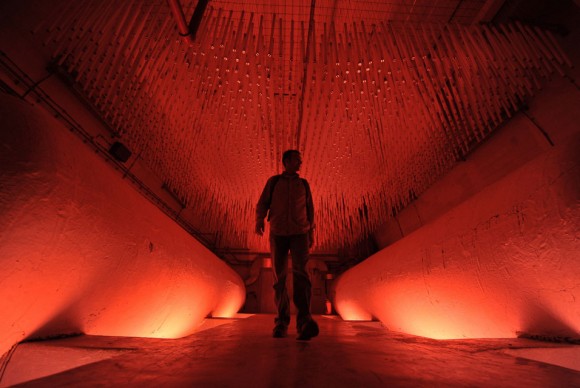Cold War bunker in Bosnia revived by modern art
May 5, 2013 by All Art News
Filed under Featured, Museums & Galleries
KONJIC (AFP).- Obsolete and lifeless for years, a secret anti-nuclear shelter built inside a remote Bosnian mountain during the Cold War for Yugoslav communist leader Josip Broz Tito has opened its doors as a modern art space.
“The idea of installing a contemporary art collection in Tito’s bunker is absolutely outstanding and hilarious,” said French artist and gallery owner Pierre Courtin, one of a number of international artists attending the recent opening of an exhibition at the bunker.
The mysterious shelter is certainly a source of inspiration for artists, he said.
“This is not a neutral place…. It has such a physical presence which presents a huge challenge for artists to exhibit in it,” he said.
Thirty artists from 19 countries have their works on display in the huge bunker, which lies near to the southern Bosnian town of Konjic.

A man looks at an art installation set up in a nuclear shelter in Konjic on May 11, 2011. Embedded deep inside a remote Bosnian mountain, the vast, top-secret bunker built to shield Yugoslavia’s iconic communist leader Josip Broz Tito from a nuclear attack has been converted into an art gallery. For its first exhibition, Military Installation D-0 — as the hideout for Josip Broz Tito is officially called — is hosting a contemporary show called “Time Machine”. AFP PHOTO / ELVIS BARUKCIC.
The military installation “ARK D-0″ was constructed under the highest secrecy measures by Yugoslav army experts from 1953 to 1979.
Some $4.5 billion (3.4 billion euros) were reportedly invested in the construction of the shelter, planned as a command centre for Marshal Tito in case of a nuclear attack on Yugoslavia, which fell apart in a series of bloody wars in the 1990s.
It was equipped with rooms and offices for the controversial leader — whose death in 1980 heralded the bloody breakup of the Yugoslav federation a decade later — and his officers. But Tito died a year after it was finished and never saw his underground hideout.
Horseshoe-shaped, the bunker, dug deep into the rock, is composed of 12 blocks covering a total area of 6,500 square metres (10,800 square feet), and designed to accommodate 350 people.
Now, 30 years after its construction, the memory of the shelter’s Cold War past has come alive again through the works gracing its walls.
Photos decorate the long corridors of the underground settlement, while sounds and light-and-video installations seek to bring the fears of a nuclear attack to life — and give goosebumps to visitors.
Numerous rooms, conference halls and communication centres have been transformed into small, and unique, galleries.
“We have chosen artists who felt able to meet specific challenges of this place, which is not a simple gallery and requires patience, ingenuity and vision,” said curator Branko Franceschi.
These latest artworks will join 40 others put up in the bunker in 2011, paving the way for a permanent collection which can be enriched over the years. Like the first exhibition two years ago, this one will only stay open for three months, but the hope is for it to open permanently, curators say.
“It is a hybrid of a military and contemporary art museum. Both will be complementary and create a unique synergy,” Franceschi said.
For the artists, the Cold War theme is a major draw that allows them to explore feelings of fear and paranoia that are still pertinent today, they say.
“This bunker is a monument, a monument to ideological divisions, a divided Europe and a polarised world…. These questions are still relevant because we live in a climate of division and fear nowadays,” said artist Conor McGrady, from Northern Ireland.
Project manager Edo Hozic has played on the long-standing veil of secrecy surrounding the bunker to make its revival a success.
“Everyone is attracted to secrets. All bunkers radiate repulsive energy, but it seems that we have been able to change the energy of this vast place whose original reason for existence has no sense nowadays,” he said.
But artist Pierre Courtin still thinks producing a work especially for the bunker must be “very difficult” with “all the weight of the past, of history”.
His favourite works, he said, are those “that have a feeling of being really made for this place”, pointing at a large mirror shattered onto the ground in one of the corridors — a creation by Italian artist Alfredo Pirri.
“This really is a work that can only exist here and cannot be moved,” said Courtin.
